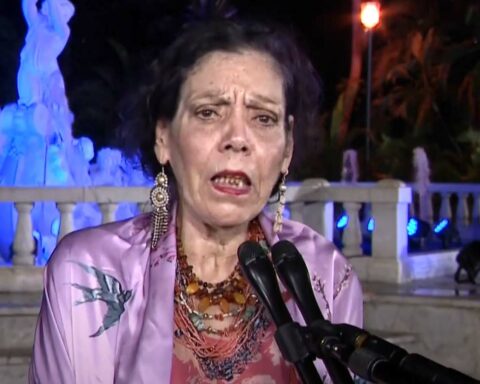Tropical storm Bonnie touched down in San Juan de Nicaragua at nine o’clock at night on Friday, July 1, according to the most recent report from the Nicaraguan Institute for Territorial Studies (INETER).
The phenomenon has moved in the national territory, almost leaving Lake Nicaragua and seeking the department of Rivas, according to the information from the United States National Oceanic Administration (NOAA).
According to a report from the National Hurricane Center (CNH), published at 5:45 a.m. this Saturday, July 2, Bonnie is expected to soon leave the country and “submerge over the Pacific Ocean.”
However, CNH experts warn that flash floods and mudslides can be generated over sectors of Nicaragua and Costa Rica this Saturday.
At 3 am this Saturday according to the National Hurricane Center the tropical storm Bonnie It was located on Lake Nicaragua. The maximum sustained winds of the phenomenon continue to decrease: at 8:30 pm they were 85 km/h, at midnight 75 m/h and this morning 65 km/h, and they remain so until this time.
“On the forecast track, Bonnie will emerge over the eastern Pacific Ocean in the next few hours. Bonnie will then move offshore but parallel to the coasts of El Salvador, Guatemala, and southern Mexico from today through Tuesday,” the CNH said in its recent report.
The tropical storm will strengthen once it emerges over the eastern Pacific this Saturday. The rains related to the phenomenon are expected to continue.
Nicaragua under green and yellow alert
Nicaragua has been under a green and yellow alert since this Friday, with its emergency systems activated due to the threat of the storm. “Our main goal is to save lives. In this work we are still adapting”, said the dictator Daniel Ortega during a television appearance.
However, the president did not provide details on the evacuation plans, the number of people who have been taken to shelters to protect them and only reviewed the history of Nicaragua and its hurricanes.
Ortega was accompanied by the number two of the regime, his wife Rosario Murillo, but also by the head of the Army, General Julio César Avilés.
“We hope that, thanks to God, we will not have any victims to mourn,” he said, “but there is still a way to go, which does not depend on us, it depends on the force of nature.”
Starting at noon this Friday, July 1, the Ortega regime decreed a green and yellow alert throughout Nicaragua, before the storm ingress Bonnie, which would be causing heavy rains mainly in the South Caribbean area.
According to the 9:00 pm bulletin this Friday from the National Hurricane Center (NHC), “Bonnie” entered the country with maximum sustained winds of 85 kilometers per hour and stronger gusts. It is likely to weaken as the center of the storm crosses Nicaragua and Costa Rica, the US NHC said.
“Bonnie is moving west near 26 km/h and a continued westward motion with a gradual decrease in forward speed is expected through Saturday night. A west-northwestward motion is expected to begin late Saturday night or Sunday and continue through Monday.
The tropical storm is expected to move across southern Nicaragua and northern Costa Rica on Friday night and exit over the eastern Pacific Ocean on Saturday. The system will then move offshore but parallel to the coasts of El Salvador, Guatemala and southern Mexico from Saturday to Monday.
Ineter expected last night that the storm would cross the country, through the south of El Rama, the south of Nueva Guinea, the southern part of Lake Nicaragua and will reach the Pacific Ocean at some point very close to Tola, in Rivas, explained the director of Ineter meteorology, Marcio Baca.
Copious rain in San Juan de Nicaragua
An inhabitant of San Juan de Nicaragua, who we identified as “Julia”, said that she did not accept being transferred to a shelter, because the house where she lives with her mother “is safe”. She added that the rain did not stop throughout this Friday, but no damage to basic services was reported.
Another person, who agreed to speak on condition of anonymity, pointed out that the evacuees come from Hallover, Spanish Creek, Caño Cocal, Cangrejera, which are located in the coastal zone of the Rama y Kriol Territory, in the surroundings of San Juan de Nicaragua, also known as like Greytown.
She added that if there was a need to evacuate all the inhabitants of San Juan de Nicaragua, the authorities informed them that “they would take us to the side of the San Juan River, but I’m not sure where exactly,” she said. In the place they also arranged as shelters the Angelica school, the Morava church and the Catholic
“Right now there is rain and wind. The electricity has not been cut, nor has the signal, ”he said on Friday night.
“I cannot calculate how many people have evacuated, but I do know that the Army, the mayor’s office, the communal governments and other institutions have been on the move since early,” said the source from San Juan de Nicaragua.
252 people evacuated, according to official media
According to official media, a group of 27 people from Monkey Point was sheltered on July 1 in shelters in Bluefields. Another note from the Nicaraguan Army indicates that between this Thursday and Friday they evacuated 225 people from six communities:
There were 87 people from Cayos Miskitos, among them, a minor; from Wawa Bar 45 inhabitants, including 23 minors; from Wounta, 29 people, including 16 minors; Cayos Perlas, eight people, among them, a minor; Monkey Point 27 people, including 15 minors and from Río Maíz, 29 people, including 15 minors. They were taken to shelters in Puerto Cabezas and Bluefields.
“During the evacuation, forces and means were used who complied with the protection measures directed by the Ministry of Health (MINSA), to prevent the spread of COVID-19,” the press release indicated.







